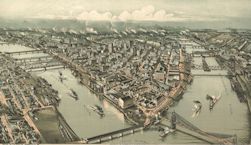Pittsburgh, Pennsylvania, in 1902
The locomotive was blowing its whistle more and more frequently as the train steamed through grade
crossings, indicating they were nearing a city. . . . The smoke of Pittsburgh rose heavily on the horizon
and soon they were trundling between mills and plants. Endless rows of chimney stacks, tall and straight
as blackened forests, lined both sides of the Monongahela River, which was . . . crowded with tall
stern-wheeled steamboats pushing long rows of coal barges. The coal was heaped everywhere . . .
black mountains to burn in glass factories, blast furnaces, open-hearth smelters, coking plants, and gashouses,
and in hundreds of locomotives pulling thousands of railcars on broadways that were eight, 10, 12 tracks
wide. . . . They passed banks of gigantic blast furnaces, the heart of the Homestead Steel Works,
which spread over hundreds of acres on both sides of a bend in the river.1 Pittsburgh is at the confluence of the Monogahela and Allegheny rivers, whick unite at the business
district (aka the Golden Triangle) to form the Ohio River. In 1902 the city was served by over six
railroad lines. The two chief industries were the production of iron and steel — and it was also known as
the Iron City. Its major products at that time were locomotives, bridges, cannon balls, brakes, all
sizes of nails, and the most delicate watch springs. The illustration shows Pittsburgh and the
rivers in 1902.2
Pittsburgh is at the confluence of the Monogahela and Allegheny rivers, whick unite at the business
district (aka the Golden Triangle) to form the Ohio River. In 1902 the city was served by over six
railroad lines. The two chief industries were the production of iron and steel — and it was also known as
the Iron City. Its major products at that time were locomotives, bridges, cannon balls, brakes, all
sizes of nails, and the most delicate watch springs. The illustration shows Pittsburgh and the
rivers in 1902.2Pittsburgh is, unfortunately, also very well known as the location of the Homestead Battle of 1892. Click here for details and period photographs. |
|
1from "The Striker" by Clive Cussler and Justin Scott. Chapter 8, page 71, Copyright © 2013 by Sandecker, RLLLP. 2from Library of Congress, Title: Pittsburgh, Pennsylvania 1902. Format: Maps. Published: Morrisville, Pa., T. M. Fowler & James B. Moyer. |